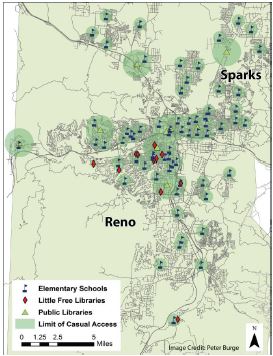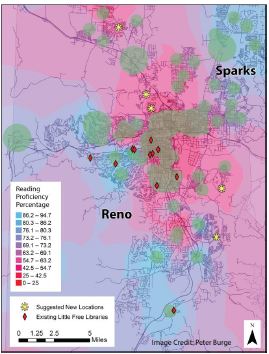Introduction
Little Free Libraries (LFLs) provide opportunities for increased access to books and reading material for children. LFLs are small custom-built freestanding boxes that house 20 to 100 books. Over 32,000 officially registered LFLs exist; they are in all 50 U.S. States and over 70 countries worldwide (Little Free Library, accessed 23 September 2016). For a more complete description of LFLs, especially regarding their history, purpose and how to get one started in your community, please refer to University of Nevada Cooperative Extension Fact Sheet-15-00: Little Free Libraries in Nevada: What, Why, and How.
Little Free Libraries (LFLs) can provide an opportunity for increased access to books and reading material for children, especially in areas that may lack easy accessibility to such resources. Increased access to books for youth can have a direct impact on literacy rates (Annie E. Casey Foundation, 2013). Literacy is an important issue in Nevada. Nevada is ranked 43rd in the nation for elementary reading proficiency (Nation’s Report Card, 2013), and research strongly indicates a direct relationship between grade reading level proficiency and high school graduation rates (Annie E. Casey Foundation, 2013). Finding a strategic location for an LFL is an important decision that can have a positive impact in the community and provide more opportunities for books. This fact sheet shares how geospatial analysis can create stronger awareness of literacy issues and help identify strategic locations for LFLs where young readers may benefit the most. Information regarding availability to fourth-grade reading material from public sites such as elementary schools, public libraries and existing LFLs, as well as fourth-grade reading proficiency test scores per elementary school in Washoe County has been summarized in this fact sheet. Fourth-grade reading proficiency is considered an important predictor for school success (Annie E. Casey Foundation, 2013). Information was collected and tabulated to help identify strategic future locations of LFLs across Washoe County. These strategic locations may have the greatest benefit for young and struggling readers in our community, thus increasing access to reading material for our young readers.
Methods:
Three types of data points were explored and analyzed:
- Zip Code Tabulation Areas (ZCTA) spatial data was created from the U.S. Census Bureau (Census Bureau, 2010);
- Public access to reading material in regard to 1) public libraries, b) elementary schools, and c) Little Free Libraries (Census Bureau 2010) and;
- Fourth-Grade Reading Proficiency test score data (Nevada Department of Education, 2015).
A travel distance was calculated for each of the three public access sites for reading material (i.e., public library, elementary school and LFL) to determine a reasonable distance an individual might travel to obtain reading material. The following limit of “casual access” was determined.
Casual access is determined by how far an individual might casually travel to obtain reading material. Casual access for a public library was determined to be one mile, for an elementary school 2,400 feet, and 1,200 feet for an LFL. Casual access to reach a community LFL was assumed as a leisurely neighborhood walk (Figure 1).
Figure 1. Casual Access to Reading Material.

Once locations of public libraries, elementary schools and existing Little Free Libraries are plotted on a GIS map, an image begins to unfold that depicts the limit of casual access to reading material for elementary students (Figure 1). Next, a Geospatial Analysis was conducted to examine reading proficiency test scores by elementary school. Each elementary school in Washoe County is required by the Nevada Department of Education to complete standardized reading proficiency tests. Test scores for each elementary school are displayed in a horizontal bar graph, indicating school name, color-coded bar line, and the schools percentage rating on the Fourth-Grade Reading Proficiency test (Figure 2). Reading Proficiency scores are color coded and displayed in progression, from blue to red, to reflect reading proficiency. Schools that score 70 percent or higher are noted with blue color bars, while schools that score below 70 percent are noted by grey-purple to red bars (Figure 2).
Washoe County Elementary Schools 4th Grade Reading Proficiency
Information from Figure 1 and Figure 2 is overlaid to create a color-coded map that highlights community zones with reading proficiency test scores and residential areas to be targeted for potential LFL placement (Figure 3).
Figure 3. Reading Proficiency With Strategic Locations of LFLs Plotted.

As shown in Figure 3, geographic zones highlighted in blue represent higher reading test scores on the Fourth-Grade Reading Proficiency Test. Geographic zones denoted in pink to red on the map (Figure 3) indicate lower reading proficiency test scores. Existing LFLs are plotted on the map, as well as suggested locations for stewards, hosts, local businesses, or organizations to consider for starting future LFLs within the pink to red zones in the community (Figure 3). Visually mapping the community to indicate access to reading materials, as well as displaying the limited proximity to available sources and the spatial relationship to schools with low reading proficiency scores, provides a method to strategically identify locations for future LFLs. The suggested LFL sites may provide increased access to books for young students who could potentially benefit the most in our community.
Conclusions:
Elementary schools and public libraries are important and traditional locations for reading materials for young and old residents alike. However, when examining grade reading level scores and proximity to access to literacy resources, these results highlight the need to focus our efforts on providing additional access to reading materials. These strategic locations as depicted in pink to red zones (Figure 3) serve as possible future locations where young students may benefit the most from a Little Free Library placement.
References:
Annie E. Casey Foundation (2013). Early Warning Confirmed: A Research Update on Third Grade Reading. Annie E. Casey Foundation, Baltimore, MD.
Nation’s Report Card. (2013). U.S. Department of Education, Institute of Education Sciences, National Center for Education Statistics, National Assessment of Educational Progress (NAEP), Mathematics and Reading Assessments.
Nevada Education Data Book (2015). Nevada Legislative Counsel Bureau.
Longley, P., Goodchild, M., Maguire, D., and Rhind, D. (2011). Geographic Information Systems and Science 3e. Wiley Publishers.
United States Census Bureau Zip Code Tabulation Area (ZCTA).
Burge, P. and Rebori, M.
2016,
Little Free Libraries: Strategic Future Locations in the Reno Sparks Area,
University of Nevada Cooperative Extension, Fact Sheet-16-08


